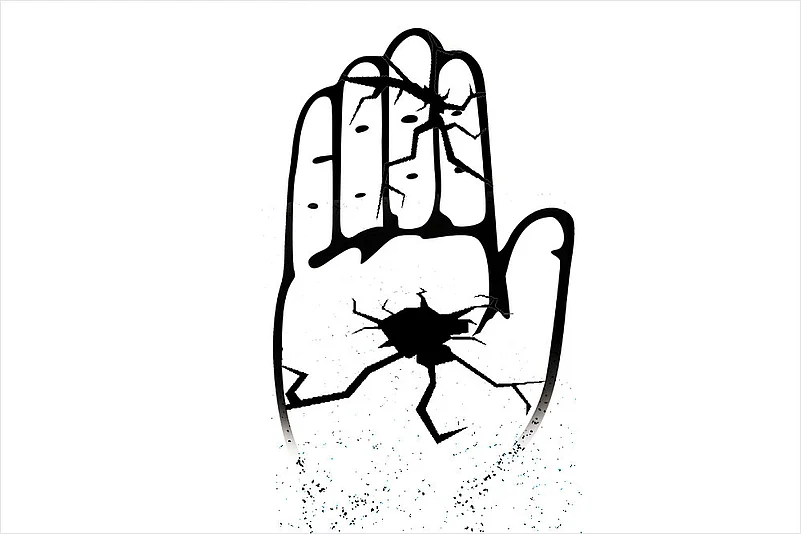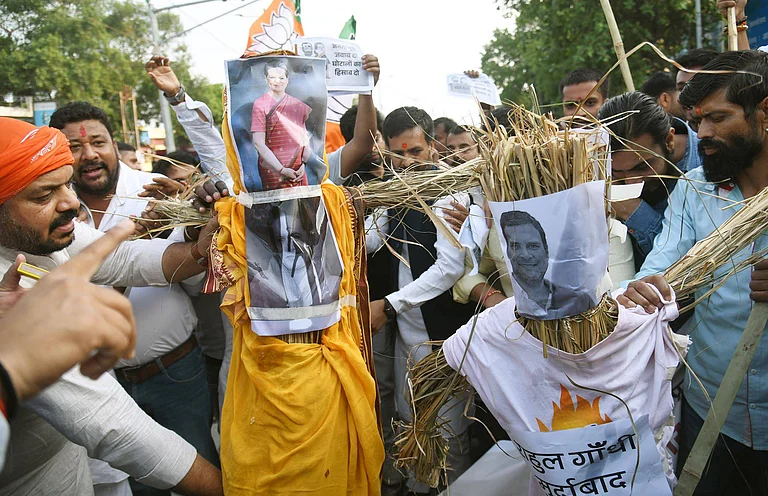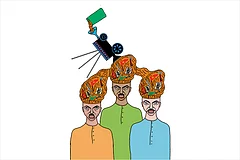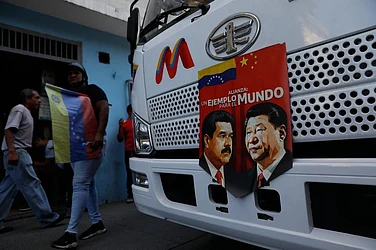A political party’s ideological profile is defined and shaped as much by its founding principles as by the opposition it faces at any time. The political party that dynamically fails to adjust its sails to the changing winds of global currents and internal storms inevitability gets marginalised. No political party can afford to remain stranded on an island of ideological purity.
The Indian National Congress (INC) is no exception to this rule. If it has survived for so long, it is only because of its ability to fine-tune its ideological pretensions and postures to answer the ever-changing Indian realities. This capacity for adaptability has often exasperated the purists and baffled the rivals and opponents.
I
Preoccupied as it was in the first 20 years (1947-1967) after Independence with national reorganisation and constitutional consolidation, the INC had to necessarily carry on its pre-Independence identity as an umbrella party, accommodating and amenable to one and all, as long they pretended to subscribe to the Idea of India. The party boss, Sardar Patel, frowned upon any ideological assertions. He ran the Congress Socialist Party out of the Indian National Congress.
The Congress stood drained of influential voices like Acharya Narendra Dev, Jaiprakash Narain, Acharya Kriplani, N G Ranga, and Ram Manohar Lohia. The Congress bosses were content to pursue power and office, as Nehru-Patel performed in jugalbandi to address the urgent and desperate task of carving a new Indian state out of post-Partition chaos and giving it a new instrument of legitimacy, the Constitution of India.
For the next 20 years, the Congress avoided acquiring sharp ideological edges, even as it faced opposition from the extreme Left to extreme Right; the Hindu Mahasabha and the Jana Sangh and the Swatantra Party on the right, to the Socialists in various incarnations in no-man’s-land to the Communist Parties on the Left. “The Middle Path” became its lazy choice, notwithstanding Jawaharlal Nehru’s infatuation with “socialist” thoughts. The Middle Path was non-disruptive, gradual, incrementalist and non-ideological, and it suited the Indian genius for civilisational ambiguity.
If the Congress has survived for so long, it is only because of its ability to fine-tune its ideological pretensions and postures to answer the ever-changing Indian realities.
No wonder the Congress reaped bumper electoral harvests in the first three national elections—1952, 1957 and 1962. By the time the Fourth General Elections came around, so frustrated were the Congress rivals at its political and electoral supremacy that they began subscribing to the ideology of non-Congressism. For the Opposition, the strategic objective was to end the Congress monopoly on national power—whatever may be the ideological compromises.
Madhu Limaye was the principal and the most persuasive ideologue of the new ideology:
“To end the Congress monopoly of power and destroy the Congress rule which has become the graveyard of all ideologies and programmes, therefore became the principal task of the Opposition and the people. A divided Opposition or a purely ideological front could not defeat the Congress. Besides, the Western ideological labels of Left and Right were to some extent irrelevant in the Indian situation.”
So intoxicating became this slogan of non-Congressism that it turned out to be a licence for ideological promiscuity. The compulsion to enter electoral alliances and form coalition governments buried all ideological pretensions. For example, in Madras (now Tamil Nadu), the DMK had both the Swatantra Party and the Communist Party of India (Marxist) as its alliance partners as it dislodged the Congress Party from Fort St. George.
II
The Congress’ answer to this non-ideological ganging up was a hefty dose of ideology: engaging her own party bosses, the Syndicate, in a battle for control over the Congress, Prime Minister Indira Gandhi went radical, nationalising 14 banks and abolishing Princes’ privy purses. Not only did she dub all her opponents, inside and outside the Congress, as “reactionary”, Indira Gandhi also resorted to “mass politics.”
For the first time, New Delhi witnessed the curious spectacle of “crowds” thronging the Prime Minister’s residence and she, in turn, acknowledged the “multitudes.” Unknowingly, Indira Gandhi had started India’s experiment with street power/jaan shakti.
By her radical posturing, Indira Gandhi, once again, forced all major political rivals and opponents to declare their ideological preferences. A kind of re-alignment of political forces took place; some socialists and the CPI (I) found themselves propping up Mrs Gandhi’s (minority) government after the split in the Congress Parliamentary Party.
Curiously enough, there was a debate within the Jan Sangh over whether her “radical politics” was rooted in an ideological anchor or was just a personality-driven populist posturing. The majority faction, led by A B Vajpayee, decided that Gandhi was not ideological but power-driven. Between 1969 and 1971, Indian polity became entrapped in the ideology of personality and charisma.
Then began the tragedy of the Congress. The 1971 Lok Sabha election became a referendum on Gandhi and her ability to lead the country as prime minister. And, when her faction of the Congress decisively prevailed over all other rivals, the Indira cult got the imprimatur of popular acceptance. Nine months later, an empowered Gandhi was able to decisively mobilise the Indian State’s military, bureaucratic, diplomatic and political energies to prevail over Pakistan in the Bangladesh War; the legend of Indira Gandhi was born.
This, sadly enough, also discredited and eventually decimated the idea of ideology as the driving force behind the grand choices the nation would make in its journey; instead, a leader and her personality came to be defied as the compelling and primary source of national inspiration and imagination. Inevitably, for her political rivals, Gandhi’s personality, its flaws and failures were deemed to be the singular handicap in achieving national greatness. Whosoever sliced it, the personality took precedence over ideological preferences.
Thus began the era of the “Nehru-Gandhi Family” in the Congress. Since Gandhi was universally acknowledged as the dominant vote-catcher, the only face with an all-India persona, the one embodiment of the Congress values and virtues, she could command and commandeer the entire Congress hierarchy as per her whims and fancies. And, when unthinkingly, the Opposition parties sought to make a hoo-ha over her son Sanjay’s business activities, the idea of “Family” got entrenched, both in and out of the Congress. “The Family” became the ideology of the Congress.
III
The Emergency, Gandhi’s total rejection in the 1977 General Election and her subsequent triumphant return to power in 1980, consecrated the centrality of the Family in the Congress scheme of things. The Congress invited the voters to exercise their franchise in relation to Gandhi:
Na jaat pe, na paat pe,
Mohar laage ge, haath pe,
Indirajee ke naam pe
(Neither caste nor religion, what matters is Indira’s name)
The Congress now knows no ideology other than the Family. Sonia, Rahul and Priyanka, inevitably, are the final arbiters of whatever stance Congress takes or does not take.
More pertinently, the 1980 vote was a massive re-affirmation of Sanjay as the second most powerful presence in the Congress; only two years ago, this young man was vilified as the most hated villain but now he was hailed as the principal architect of the Congress’ return to power. It was he who refused to be browbeaten by the old men of the Janata Party government, and instead, undertook perhaps the only large-scale shaking up of the Congress leadership slate at the national and state levels.
The Congress, from top to bottom, now felt totally beholden to the Family; a convenient myth subtly cultivated was that the “Nehru-Gandhi Family” was uniquely and intrinsically blessed with unparalleled leadership qualities and that it enjoyed a natural bond with the masses.
And, when Sanjay died in a plane crash within months of the 1980 triumph, it was deemed the most natural that Rajiv should step in as the principal aide to his mother, the Prime Minister, and the Congress President. The Congress Party was now most consequentially entrapped in the myths of the Family and its omnipotence.
In this mythology, the Family was the only source of ideology, imagination, ideas, idealism, and innovation—and, of course, the only site of power and legitimacy within the Congress. So, when Gandhi got assassinated, the Congress honchos did not have the slightest doubt that only her son, Rajiv, could succeed her as the prime minister and the Congress President. [Though it needs to be noted that the first dynastic succession in India had already taken place in Jammu and Kashmir when Farooq Abdullah succeeded the legendary Sheikh Abdullah as the chief minister].
This Family template was the very antithesis of an ideological profile. Whereas an ideology binds and is binding on both the leader and the led, the Family template absolves the leader of any ideological steadfastness. Ideology, if any, was to be gleaned from the (Family) Leader’s style, choice of advisers. Be it Sanjay, or Indira or Rajiv, each sought to express his/her ideological orientation in terms of “X-Point Programmes” or “Missions or “guarantees”.
By the time Rajiv ascended the “throne,” ideological orientations—and grand constitutional commitments—had totally dissolved into confusing ambiguities. It was, therefore, inevitable that when confronted with an incipient Hindutva challenge, the Rajiv coterie floundered. It was also inevitable that Rajiv would squander the massive 400-plus Lok Sabha seats mandate. And, again, the desire and desperation to get rid of a scion of the Family was so total that both the Left and the Right joined hands to provide support to the V P Singh interlude.
Rajiv’s assassination in 1991 reinforced the myth of the Family. Sonia Gandhi cultivated a mystique about her as the final arbiter of the Congress’ values and ideological commitments, even when Prime Minister P V Narasimha Rao, aided and abetted by his finance minister, Dr Manmohan Singh, quietly dismantled the Nehruvian model of economic development. The Indian State vacated the “commanding heights of the economy” and the Market, with a capital M, was invited to do its magic.
The 1991 paradigmatic shift transformed the economy and also loosened up the social landscape, already reeling under the impact of Mandir and Mandal politics. And, though the Congress could innovate and readjust its ideological commitments, its internal equations remained entangled in the myths of the Family. Two successive defeats, in 1996 and 1998, made the party once again turn to the Family talisman. In 1998, the Congress defrocked its elected president, Sitaram Kesari, and invited Sonia Gandhi to take over the party. And, the rest is history—of electoral triumphs and disasters and, ideological confusion.
IV
The Congress now knows no ideology other than the Family. Sonia Gandhi, Rahul Gandhi, and Priyanka continue, inevitably, as the final arbiters of whatever stance the Congress takes or does not take. Even though the party has a formally elected President, power remains undilutedly in the Family. The party derives its ideological profile and electoral persona from Rahul Gandhi—his personality quirks, his unsettled relationship with party seniors, his intellectual angst, his choice of “advisers” and cronies, and his sense of entitlement.
And, even if the Congress may want to move away from the Family, the Narendra Modi crowd keeps harping, poking, provoking and pouncing on Rahul as the very antithesis of a muscular Hindutva agenda. For better or worse, the Congress remains trapped in the Family template.
Mercifully, the Congress and its rivals must operate within the four walls of the Constitution of India. The Constitution is the only ideology. The grand constitutional principles are supreme, and no political dispensation can be allowed to draw outside the constitutional lines. A regime, like the Modi arrangement can recourse to political subterfuge and electoral deviousness to game the constitutional arrangement, but it can also be check-mated by a vigorous Congress-led opposition. In the days and weeks to come, the Family’s capacity to summon the requisite skills, tactical innovations, and strategic imagination would be on test. But much more than the future of a Family is at stake.
(Views expressed are personal)
(This appeared in the print as 'Trapped In A Template')
MORE FROM THIS ISSUE
Harish Khare is a Delhi-based senior journalist and public commentator

































